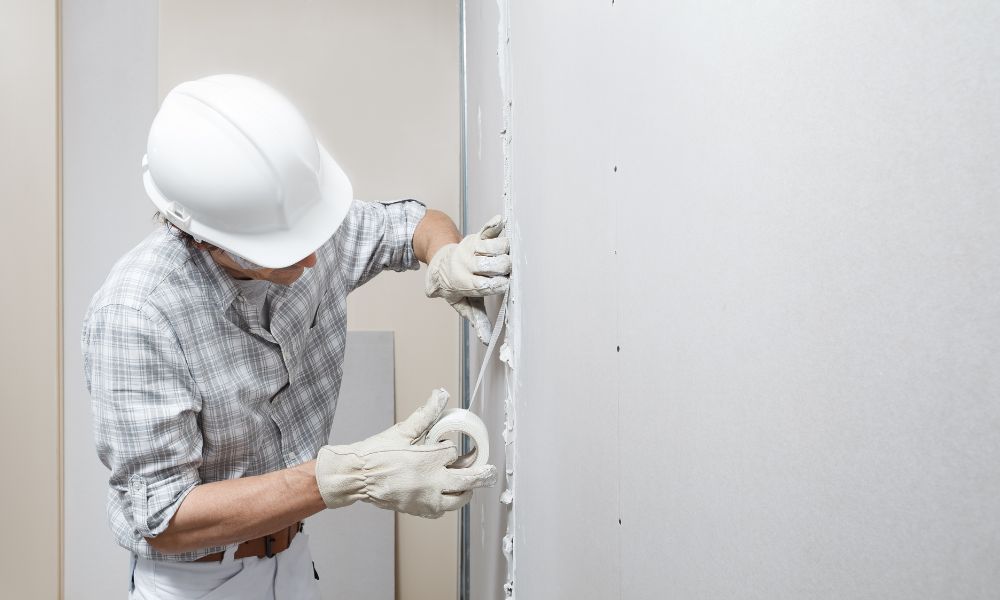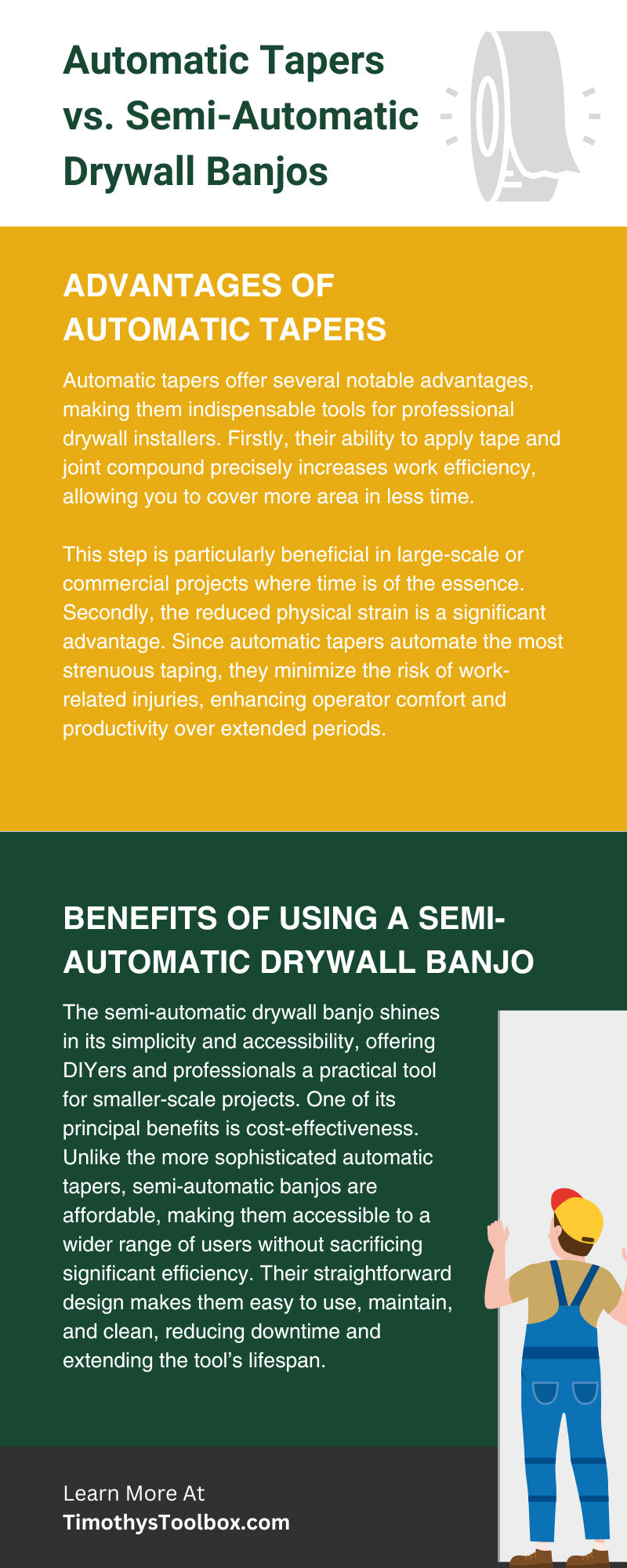Award Winning Service
Award Winning Service

In drywall installation, efficiency and precision are key to achieving a polished finish on walls and ceilings. Two tools that stand out in the quest for efficiency are the automatic taper and the semi-automatic drywall banjo. Both can streamline the taping phase of drywall installation, but they cater to different needs and skill levels.
Let’s look at everything you need to know about automatic tapers and semi-automatic drywall banjos, along with their pros and cons.
An automatic taper is a sophisticated tool that significantly speeds up the process of applying joint compound and tape to seams in drywall. This device dispenses tape efficiently and applies the right amount of joint compound over drywall seams. It can help in the initial taping phase and when covering inside corners, making it extremely versatile. One of the biggest advantages of an automatic taper is its ability to enhance productivity, enabling a professional finish in less time compared to manual methods.
Additionally, it reduces the physical strain on the user, as it automates the most labor-intensive aspects of drywall taping. However, the complexity and cost of automatic tapers can be a barrier for DIY enthusiasts or professionals who don’t frequently engage in large-scale or commercial drywall projects. Despite this, an automatic taper is an invaluable tool in the drywall installer’s arsenal for large jobs.
A semi-automatic drywall banjo is a simpler, more user-friendly tool than the automatic taper. It’s primarily for applying tape and joint compound to drywall seams but requires more manual intervention. The user fills the banjo with a joint compound, positions the tape, and manually guides the tool along the seams. Despite the manual nature of this tool, it still offers a significant speed advantage over completely manual taping methods.
One of the key advantages of the semi-automatic drywall banjo is its affordability and ease of use, making it an excellent choice for DIY enthusiasts or professionals working on smaller projects. It’s lightweight, easy to handle, and requires less maintenance than an automatic taper. However, the semi-automatic banjo may not be the most time-effective option for larger projects or those requiring efficiency.
Automatic tapers offer several notable advantages, making them indispensable tools for professional drywall installers. Firstly, their ability to apply tape and joint compound precisely increases work efficiency, allowing you to cover more area in less time.
This step is particularly beneficial in large-scale or commercial projects where time is of the essence. Secondly, the reduced physical strain is a significant advantage. Since automatic tapers automate the most strenuous taping, they minimize the risk of work-related injuries, enhancing operator comfort and productivity over extended periods.
Furthermore, the consistency of the application ensures uniform quality across the entire project and reduces the need for time-consuming corrections or touch-ups. This consistent quality finish is crucial for maintaining high standards in professional drywall installation projects. Despite the higher upfront cost, the long-term benefits of increased efficiency, reduced strain, and consistent quality make automatic tapers a valuable investment for professionals.
The semi-automatic drywall banjo shines in its simplicity and accessibility, offering DIYers and professionals a practical tool for smaller-scale projects. One of its principal benefits is cost-effectiveness. Unlike the more sophisticated automatic tapers, semi-automatic banjos are affordable, making them accessible to a wider range of users without sacrificing significant efficiency. Their straightforward design makes them easy to use, maintain, and clean, reducing downtime and extending the tool’s lifespan.
Additionally, the semi-automatic banjo promotes a hands-on approach, giving users more control over the taping process. This can be particularly advantageous for intricate work or in scenarios where precision is paramount. This blend of affordability, ease of use, and control makes the semi-automatic drywall banjo a versatile tool.
Choosing between an automatic taper and a semi-automatic drywall banjo boils down to evaluating your drywall project’s scale, budget, and specific requirements. An automatic taper is undoubtedly the best choice if you’re working on a large-scale or commercial project where efficiency and consistent quality are paramount. Its capacity to expedite the taping process while minimizing physical strain makes it an essential tool for professionals seeking to maximize productivity and maintain high quality standards.
On the other hand, for smaller projects or DIY endeavors where budget constraints are factors, a semi-automatic drywall banjo offers a perfect blend of efficiency, affordability, and control. It allows for a significant upgrade from manual taping without the hefty investment in an automatic system. Ultimately, the choice should reflect a balance between the project’s demands, the user’s expertise, and the available budget, ensuring the chosen tool complements the work rather than complicating it.
Proper maintenance and care are essential to ensure the longevity and reliability of both automatic tapers and semi-automatic drywall banjos. Regular cleaning after each use is crucial with automatic tapers to prevent the buildup of dry joint compounds, which can impair their functionality.
You should also periodically lubricate moving parts to ensure smooth operation. Semi-automatic banjos, while simpler, still require diligence in cleaning to maintain efficiency, focusing especially on the tape path to ensure it remains free of obstructions. In both cases, storage in a clean, dry environment can prevent rust and other damage that could shorten the tool’s lifespan.
Additionally, inspecting the tools before use can help you identify any wear and tear that might affect performance, allowing for timely repairs or replacements. By following these maintenance tips, users can preserve the effectiveness and extend the life of their drywall taping tools, ensuring they continue to deliver superior results on every project.
Both automatic tapers and semi-automatic drywall banjos have unique features that can significantly benefit installation projects, depending on the scale, budget, and specific job demands. By understanding each tool’s advantages and considering your project’s specific requirements, you can make an informed choice that enhances your productivity and achieves professional results. Remember, proper maintenance and care are crucial to ensure longevity and peak performance in your drywall installation endeavors, regardless of the tool you choose.
If you need a banjo drywall tool to enhance your taping process, Timothy’s Toolbox has a wide selection of both automatic tapers and semi-automatic banjos. Whether you’re a professional or DIY enthusiast, our high-quality tools will help you achieve a polished finish on your drywall projects. Shop with us today and experience the difference.

{"one"=>"Select 2 or 3 items to compare", "other"=>"{{ count }} of 3 items selected"}
Leave a comment